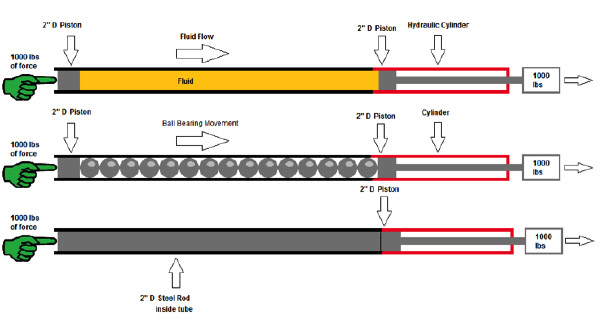“Pressure makes it go; flow is the rate in which you can create pressure.” –Cosford’s Law
If you’ve been around fluid power for more than a week, you’ve heard the phrase “Flow makes it go.” The first thing I was taught about hydraulics was that “pressure is resistance to flow, and pumps only create flow.” It’s a bunch of hogwash, but instead of complaining that this false concept is still taught, I’ll just show you how motion is really created.
Consider the example in my illustration below. I have three 2-in. diameter cylinders each butt-welded to 2-in. diameter tubes. The first tube is filled with oil, the second tube is filled with ball bearings and the third tube is filled with a solid steel rod.
You will notice the first two cylinders each have a 2-in. diameter piston to contain both the oil and the bearings. Finally, I’ve asked the Credible Hulk to push on left side in hopes of moving our 1000 lb weights on the right side. I challenge anyone to tell me how any of these examples are functionally different, especially if our X-ray eyes couldn’t see inside the tubes!
In the first example, Credible Hulk pushes on the piston with 1000 lb of force, which pushes on the fluid with 1000 lb of force, which pushes on the cylinder’s piston with 1000 lb of force, which pushes on the rod with 1000 lb of force, which itself pushes on the 1000 lb resistance. Phew, that’s a lot of pushing, but as far as the Credible Hulk is concerned, his pushing on the piston caused the 1000-lb weight to move.
In the second and third examples, when the Credible Hulk pushes on either the piston or steel rod, the 1000-lb weight moves, just like with the first example. The only difference between the “fluid rod” in the first example and the steel rod in the third example, is that the fluid’s molecules are free to slide around and move about inside the tube. However, force is still transmitted along the same vector as is pushed against the piston by Credible Hulk.
Before you attempt to argue the 1000-lb weight moved because flow was created by the left side piston, consider the words of someone with even more trustworthiness than Credible Hulk; Sir Isaac Newton. His Second Law of Motion states, “Acceleration is produced when a force acts on a mass.” Physical objects can only be set into motion when force is applied to them, and this includes oil molecules. What occurs during “flow” of hydraulic fluid, is that pressure is allowing flow to occur, not the other way around.
If my pressure compensated hydraulic pump is capable 100 gpm, with the compensator is set at 1000 psi, how quickly can it move a cylinder load requiring 1001 pi? That’s right, my cylinder won’t move a single inch. Even if the pump was capable of a billion gpm, if there is not a differential of pressure in favor of the pump, no flow can occur. This is because “flow” is not the generator of motion, but just the time factor applied to the quantity of force being applied.
Pressure always starts at the pump, which is why flow can happen. If there is no downstream restriction or mass to move, fractional pressure is still required to move the fluid, even if it’s air. The only reason a restriction or mass creates pressure is because of Newton’s Third Law that every action has an equal and opposite reaction. The pump adds the force into the fluid, and the pressure raises equally and oppositely to that force until the force from the pump is greater, allowing flow to occur.
A hydraulic pump is no different, and you could easily translate the examples of the illustration into the operation of a piston pump. Every time a piston in a pump reciprocates, it applies force to the fluid, which is transmitted ultimately to the actuator(s). A vane or gear is no different, but the geometry is not so simple to visualize as my previous example.
Finally, you might think it to be narcissistic of me to create my own physical law, but as a member of the fluid power community with an obligation to influence and educate others, I couldn’t sit by and watch “Flow Makes it Go” confuse students and professionals alike. “Pressure makes it go: flow is the rate in which you can create pressure” might not have the same ring, but hopefully the concept of Cosford’s Law is understood regardless.



“flow doesn’t make motion, flow is motion”
/akkamaan
Actually, the load will not move. 1000 LBS Push Force = 1000 LBS LOAD, The push force needs to be greater than 1000 LBS to get the load to move. The presented problem is currently in a force balance. No motion.
Brent, great observation. I have a feeling Credible Hulk has that extra pound within him. 😉
Force balance can even occur in motion (constant speed). If we assume that The Incredible Hulk has already got the motion started.
However, acceleration (negative or positive) can not occur in force balance
/akkamaan